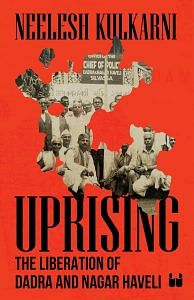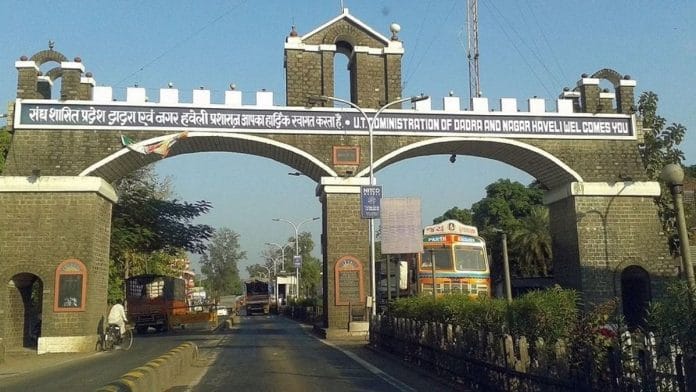The takeover of the territories of Dadra and Nagar Haveli began with negotiations over compensation for the Santana, a Portuguese warship with 120 sailors and forty cannons that had been captured by the Maratha general Janoji Dhulap in 1772. The Portuguese had asked the ruler, Peshwa Madhav Rao I, to return the vessel to them, but the request was turned down. The matter rested there until 1776 when, taking advantage of the weakening of the Maratha empire, the Portuguese resurrected their demand.
It was a difficult period for the Maratha confederacy. First, Ahmad Shah Abdali delivered them a crushing defeat in the Third Battle of Panipat in 1761—an entire generation was wiped out. Additionally, Peshwa Madhav Rao I, who had single-handedly stabilized the empire and was responsible for the turnaround in Maratha fortunes, died in 1772 at the age of twenty-seven. His demise set up a feud for the title of Peshwa that would eventually cost the Marathas their supremacy.
On the death of Madhavrao, his uncle Raghunathrao Bhat, or Raghoba Dada, staked his claim to be appointed the next Peshwa. However, when Shivaji III, the titular head of the Maratha confederacy, appointed Madhavrao’s sixteen-year-old brother Narayanrao as the next Peshwa instead, Raghoba had him brutally murdered and assumed the title of Peshwa anyway, which is how such matters were usually settled in those days. As one of the versions of the legend goes, Raghoba sent a note to the head of a gang of mercenaries he employed which read ‘Narayanrao na dharave’ (arrest Narayanrao). His ambitious second wife Anandibai used a bit of kohl to change the alphabet ‘dha’ in ‘dharave’ to ‘ma’, making it ‘marave’ or kill. Upon being chased by the mercenaries, Narayanrao rushed to Raghoba, shouting, ‘Kaka, mala vachava,’ (Uncle, save me). Instead of saving him, Raghoba coldly observed the teenager being brutally stabbed to death.
Disturbed by this act, which was against the ethos of the Maratha court, twelve associates loyal to Madhav Rao I, later collectively called the Barbhais or twelve brothers, sought to make things right. When Raghoba was away fighting the Nizam, they gathered their forces, engaged his troops at Kasegaon, and defeated them in 1774. They then installed the five-year-old son of Narayanrao, Madhav Rao II, as the Peshwa, with Nana Fadnavis (born Balaji Janardan Bhanu) as his advisor.
Nana steered the Maratha confederacy through a long and challenging period but could not save it from the internal conflicts stemming mainly from Raghoba’s hunger for the title of Peshwa.
After the defeat of his forces at Kasegaon, Raghoba sought refuge with the British East India Company, promising them territories in return for their aid in defeating his grand-nephew’s army. Nana immediately dispatched a letter to the company, requesting their support. The company sent their representative to Fort Purandar, where the young Peshwa resided, and signed the first treaty of Purandar, by which they agreed to hand over Raghoba.
But soon afterward, Governor-General Warren Hastings expressed dissatisfaction with the terms of the treaty and threatened to go to war. The Barbhais, fully aware of the danger posed by a combined army of the British and Raghoba, swiftly acquiesced to a revised second treaty, ceding the territories promised to the company by Raghoba, and asked again that he be handed over to them.
Meanwhile, the French sent an ambassador to the court of the Peshwa, even as the Anglo-French wars were being fought in southern and eastern India. Accusing the Marathas of fraternizing with the enemy, Hastings once more reneged on the treaty’s terms and sent his forces towards Pune. In the first Anglo-Maratha war, fought near Talegaon in May 1779, the British were soundly thrashed and Raghoba was finally returned to the Marathas’ custody by the terms of a new and final treaty. Many of the territories the company had wrested via the second treaty of Purandar reverted to the Marathas, leaving the British smarting.
The Marathas treated Raghoba with respect, as deserving of a son of the valiant Bajirao Peshwa, and after extracting an undertaking from him that he would stay away from Pune, released him. He, however, broke his word and sought shelter with the Portuguese.
The Portuguese took advantage of the fact that the Marathas would not want to fight them so soon after clashing with the British. Raghoba’s arrival strengthened their position and they demanded compensation for the Santana—an issue that had been on the back-burner for well over six years. Governor José Pedro da Câmara, as the representative of Queen Maria the Pious, proposed a treaty with the Peshwa, the terms of which were negotiated by Narayan Vithal Dhume, specially loaned for this task by the Nizam of Hyderabad. The treaty proposed a permanent peace and standing together as allies against common enemies, but the signal was clear—agree to our terms or we will add to your troubles by siding with your foes. With Raghoba’s associates, including his adoptive son Amrut Rao, seeking to bring him back, the British East India Company waiting to avenge its defeat and the Nizam preparing to attack their southern flanks, Nana knew the Marathas could not afford another enemy, so he advised the Peshwa to accept the terms.
On the surface, the treaty espoused standing together against mutual adversaries, an agreement to not shelter fugitives in each other’s territories and allowing ships safe access to ports controlled by both parties. But it was really about releasing Raghoba to the Marathas in return for compensation in the form of ₹56,544 in cash, teakwood worth ₹3,000 (enough to build a ship), and saranjam (revenue collection rights) to territories in the provinces adjoining Daman. Unknown to either party, the term ‘saranjam’ would whip up a storm in the International Court of Justice in 1960 and help decide the future of the territories involved. Sixty-five villages of Dadra and Nagar Haveli were ceded in all by the Marathas. Three years later, the Portuguese bought the remaining seven from the raja of Jawhar, establishing complete hegemony over the area. The seventy-two villages, spread over 491 square kilometers and with a population of less than 20,000, yielded a revenue of ₹12,000 per annum.
Daman, where the governor was based, and the adjoining territories were categorized broadly into the districts of Damasco Grande, Naeer, Dadra, and Nagar Haveli.
Daman was a coastal town with a large garrison of Portuguese soldiers which could be bolstered by reinforcements arriving through the sea route from Goa and Diu. Dadra and Nagar Haveli were landlocked, separated from each other by a narrow strip of land, and Nagar Haveli was further separated from Daman by a thirty-five-kilometer region ruled by the raja of Dharampur. Since the raja was friendly with the Portuguese, they did not feel the need to take it over. The Portuguese territory was under the control of an administrator based in Silvassa, who reported to the governor in Daman. A chief of police and a judge were the only other Portuguese officials posted in Silvassa; the others were recruited from among the locals.
The region was bisected by the rain-fed Daman Ganga River and consisted mainly of jungles interrupted by the occasional settlement, with Silvassa being the largest. The Daman Ganga’s tributaries—Shrimant, Val, Rayte, Lendi, Vagh, Sakartond, Dongarkhedi, Roshni, and Dudhni—swelled into huge, fast-flowing waterways during the monsoons. The jungles, which housed most of the tribal populace, comprised deciduous trees with teak, sandra, mahara, and khair, bled into bordering territories such as Gujarat and Maharashtra.
Being the only territory under Portuguese occupation without direct access to the sea would alter the course of the enclave’s history—a fact that, naturally, nobody could have foreseen.
The Dhodia, Kokna, and Warli tribals, who constituted almost 80 percent of the new district’s population, lived in small villages (called ‘padas’) within the lush jungles. Each pada typically consisted of a few ramshackle huts built around a central square and had a shrine to Waghdev, the local deity. Extreme poverty was the order of the day, except for the other 20 percent of the population, which included landlords and their cohorts, many of whom had been appointed Patels or revenue collectors by the Portuguese.
Already leading miserable lives, the tribals had no idea that things were going to become worse. If someone had told them so, they would probably have laughed and taken another swig of the country liquor their Patels supplied them with so liberally.

This excerpt from Neelesh Kulkarni’s book, ‘Uprising: The Liberation of Dadra and Nagar Haveli” has been published with permission from Westland Publications Limited.






